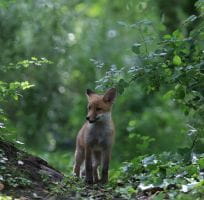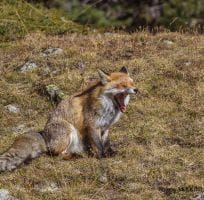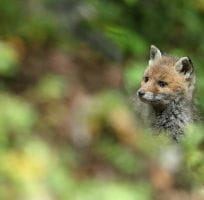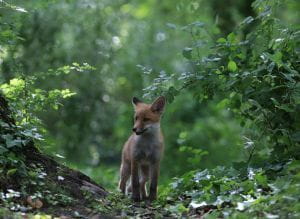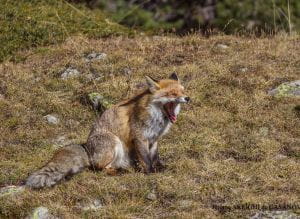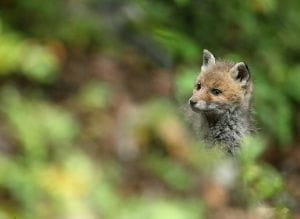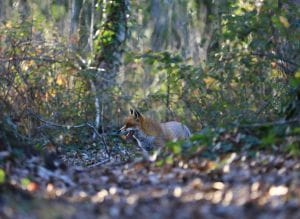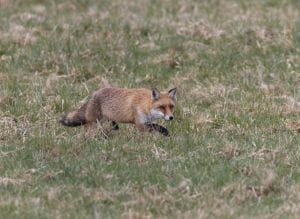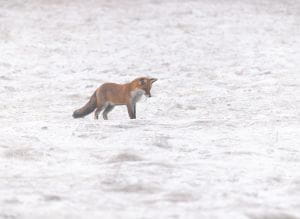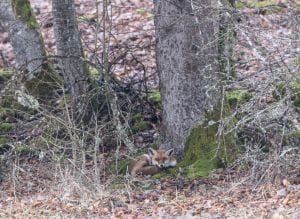However, due to physical similarity, the term is also used to designate canids belonging to other genera such as the fennec (sand fox), the American urocyon (gray fox), the cerdocyon (savannah fox), the otocyon (bat-eared fox) or the lycalopex (Argentine gray fox).
In all, more than 40 species in 15 different genera are called “foxes”.
All these “fox” species are close cousins of wolves, jackals, dholes, coyotes, wild dogs and dogs. Together, they form the large Canidae family, which appeared in North America 35 million years ago.
A common species if ever there was one…
The red fox is found just about everywhere in the world and in all environments. Its adaptability seems limitless and its mind remarkably sharp. Vulpes vulpes, the red fox, is the wild carnivorous mammal with the widest worldwide range.
It can live in a huge variety of different biomes, making it an animal adapted to all environments, even if its preferred territory seems to be a mixture of forest and scrub.
Its omnivorous diet is very varied.
Its opportunistic omnivorous diet (rodents, rabbits, insects, fish or fruit) enables it to adapt to all environments… including our cities. Where, thanks to its skill, it has become an invaluable auxiliary to pest control services!
It has colonized North and South America, Africa, Europe and Asia naturally and was introduced to Australia by man, where it is now considered an invasive species.
With a wide range of social behaviors.
While the fox’s physique is similar to that of a dog, unlike dogs (and wolves), foxes are not pack animals. Outside the breeding season, the fox is a solitary animal. However, they can alternate periods of living alone with periods in social groups when food resources are abundant. They may then remain in pairs for several years, or even form small societies with a dominant pair, as is the case with wolves. When conditions become less favorable, groups break up and individuals return to a solitary life.
A discreet and opportunistic hunter.
Small in size (35 cm at the withers for a weight varying from 3.5 to 7 kg), this carnivore hides beneath a thick coat whose tones vary from beige yellow to brown for the head and body, while the throat, underside of the belly and tip of the tail tend more towards white.
The fox is digitigrade: that is, it rests while walking or running on its toes and not on the sole of the foot (like man or bear) or on a nail (like ungulates: horses, bison, deer, …).
It shares this characteristic (digitigradia) with the majority of caniformes and feliformes.
This major adaptation enables it to move discreetly and quickly whatever the nature of the ground, thus enhancing its hunting abilities.
The fox has long been considered a rather nocturnal or at least crepuscular animal. Recent studies tend to show that it is in fact cathemeral: as active during the day as at night, depending on the environment in which it evolves.
Like many foxes, the fox is a nocturnal animal.
Like many felines (although it is a canine), it sees very well at night, and is said to be nyctalopic (thanks to vertical pupils, like a cat!).
Its hunting tactics are also much closer to those of cats than dogs or wolves. It hunts alone, stalks its prey without a sound, then waits for the opportune moment to pounce on it.
As well as having very acute hearing, the red fox is said to be able to detect the earth’s magnetic field (like certain birds and fish during their migrations). It uses this ability to locate its prey under the snow. Once they’ve located their prey, they crouch down and leap vertically into the air, before dropping headfirst into the snow, like a swimmer off a diving board. This fox hunting technique is called mulotage.
Like many carnivores, the fox marks its territory with its faeces (droppings) and communicates with fellow foxes via its scent glands (anal glands, supra-caudal gland, glands at the corners of the mouth), which provide information on its mood or sexual expectations!
It also communicates through powerful and highly varied calls. There are almost 40 of them. Most often nocturnal, these calls are also audible during the day, particularly in January and February, the species’ mating season.
A room-mate to be avoided. A discreet but curious animal, this carnivore does not hesitate to enter lodges that have remained open after dark. Luggage is carefully inspected, and beware of misplaced shoes – they’ll end up in the burrow! Remember to close your entrance at bedtime.
An exemplary family life.
At breeding time, the fox and her mate form a close-knit couple.
The breeding season starts at the beginning of January and ends in February.
After a gestation period, the fox and her mate have a very close relationship.
After a gestation period of around 8 weeks, the fox gives birth to three to seven cubs, in a burrow that she has more or less built herself. It’s not uncommon for the fox to exploit the badger’s digging skills, settling in the upper parts of one of these mustelids’ burrows.
Born blind, the cubs will open their eyes 10 days after birth. They remain in the burrow for 2 to 3 weeks, coming out only in fine weather to play while the mother hunts. They are then grayish in color, with a rounded abdomen, bulbous skull and short nose and ears.
The mother returns to nurse them regularly.
The mother returns to nurse them regularly, then, as their age advances, brings them, like the father, small prey. Soon they will begin to follow their parents on their travels and learn the hard job of predator.
The fox cubs will live under their parents’ protection until they are seven months old, when they will gain their independence. English biologists have observed that they continue to learn as necessary by playing with other species (domestic dogs, wild cats, badgers, humans, crows, magpies).
The fox protects its cubs with puzzling loyalty and love: again, in England, a fox cub was caught in a trap set by hunters. He was trapped for two weeks, but survived thanks to his mother, who came daily to bring him food!
Finally, when they live socially (several families together), “nannies” take care of raising the group’s fox cubs. Nannies can be both males and females, and the status of individuals in the group can change over time.
The red fox is a carnivore, but its diet is more that of an omnivore. Its diet is highly varied and varies with the seasons. In winter, when resources are scarce, the red fox can become necrophagous, consuming the remains of carcasses it finds on its forays.
In spring and summer, it hunts small mammals, with a preference for leporidae (rabbits and hares), small rodents or birds (passeriformes, galliformes, waterfowl). It is not uncommon to see it hunting grasshoppers and beetles on the reserve. In autumn, it is not averse to eating mushrooms or forest fruits (raspberries, blackberries and blueberries). When we tell you it’s an omnivore!
This remarkable adaptation is undoubtedly one explanation for its very wide range.
